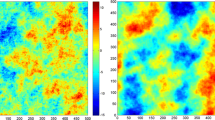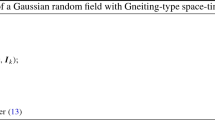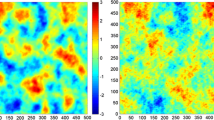Abstract
This paper presents an algorithm for simulating Gaussian random fields with zero mean and non-stationary covariance functions. The simulated field is obtained as a weighted sum of cosine waves with random frequencies and random phases, with weights that depend on the location-specific spectral density associated with the target non-stationary covariance. The applicability and accuracy of the algorithm are illustrated through synthetic examples, in which scalar and vector random fields with non-stationary Gaussian, exponential, Matérn or compactly-supported covariance models are simulated.








Similar content being viewed by others
References
Arroyo D, Emery X (2017) Spectral simulation of vector random fields with stationary Gaussian increments in d-dimensional Euclidean spaces. Stoch Environ Res Risk Assess. doi:10.1007/s00477-016-1225-7
Bochner S (1933) Monotone funktionen, Stieljessche integrale und harmonische analyse. Math Ann 108:378–410
Boisvert JB, Deutsch CV (2011) Programs for kriging and sequential Gaussian simulation with locally varying anisotropy using non-Euclidean distances. Comput Geosci 37(4):495–510
Chilès JP, Delfiner P (2012) Geostatistics: modeling spatial uncertainty, 2nd edn. Wiley, New York
Costa JF (2009) Interpolating datasets with trends: a modified median polish approach. Comput Geosci 35(11):2222–2230
Damian D, Sampson PD, Guttorp P (2000) Bayesian estimation of semi-parametric non-stationary spatial covariance structure. Environmetrics 12(2):161–178
Deutsch CV, Journel AG (1998) GSLIB: geostatistical software library and user’s guide. Oxford University Press, New York
Emery X, Lantuéjoul C (2006) TBSIM: a computer program for conditional simulation of three-dimensional Gaussian random fields via the turning bands method. Comput Geosci 32(10):1615–1628
Emery X, Lantuéjoul C (2008) A spectral approach to simulating intrinsic random fields with power and spline generalized covariances. Comput Geosci 12(1):121–132
Emery X, Arroyo D, Porcu E (2016) An improved spectral turning-bands algorithm for simulating stationary vector Gaussian random fields. Stoch Environ Res Risk Assess 30(7):1863–1873
Fouedjio F, Séguret S (2016) Predictive geological mapping using closed-form non-stationary covariance functions with locally varying anisotropy: case study at El Teniente Mine (Chile). Nat Resour Res 25(4):431–443
Fouedjio F, Desassis N, Rivoirard J (2016) A generalized convolution model and estimation for non-stationary random functions. Spat Stat 16:35–52
Fuentes M (2002) Interpolation of nonstationary air pollution processes: a spatial spectral approach. Stat Model 2(4):281–298
Goovaerts P (1997) Geostatistics for natural resources evaluation. Oxford University Press, New York
Guttorp P, Sampson PD (1994) Methods for estimating heterogeneous spatial covariance functions with environmental applications. In: Patil GP, Rao CR (eds) Handbook of statistics XII: environmental statistics. Elsevier, New York, pp 663–690
Haas TC (1990) Kriging and automated variograms modeling within a moving window. Atmos Environ Part A Gen Top 24(7):1759–1769
Harris P, Charlton M, Fotheringham AS (2010) Moving window kriging with geographically weighted variograms. Stoch Environ Res Risk Assess 24(8):1193–1209
Higdon D (2002) Space and space-time modeling using process convolutions. In: Anderson CW, Barnett V, Chatwin PC, El-Shaarawi AH (eds) Quantitative methods for current environmental issues. Springer, London, pp 37–56
Higdon D, Swall J, Kern J (1999) Non-stationary spatial modeling. In: Bernardo JM, Berger JO, Dawid AP, Smith AFM (eds) Bayesian statistics 6—proceedings of the sixth Valencia international meeting. Oxford University Press, New York, pp 761–768
Journel AG (1986) Geostatistics: models and tools for the earth sciences. Math Geol 18(1):119–140
Journel AG, Huijbregts CJ (1978) Mining geostatistics. Academic Press, London
Lantuéjoul C (2002) Geostatistical simulation: models and algorithms. Springer, Berlin
Liang M, Marcotte D (2016) A class of non-stationary covariance functions with compact support. Stoch Environ Res Risk Assess 30(3):973–987
Machuca-Mory DF, Deutsch CV (2013) Non-stationary geostatistical modeling based on distance weighted statistics and distributions. Math Geosci 45(1):31–48
Marcotte D (2015) TASC3D: a program to test the admissibility in 3D of non-linear models of coregionalization. Comput Geosci 83:168–175
Matheron G (1971) The theory of regionalized variables and its applications. Ecole des Mines de Paris, Fontainebleau
Matheron G (1973) The intrinsic random functions and their applications. Adv Appl Probab 5:439–468
Matheron G (1989) Estimating and choosing. Springer, Berlin
Monestiez P, Switzer P (1991) Semiparametric estimation of nonstationary spatial covariance models by metric multidimensional scaling. Technical report, Stanford University, USA
Nychka D, Wikle C, Royle A (2002) Multiresolution models for nonstationary spatial covariance functions. Stat Model 2(4):315–331
Paciorek CJ, Schervish MJ (2006) Spatial modelling using a new class of nonstationary covariance functions. Environmetrics 17(5):483–506
Pintore A, Holmes CC (2005) A dimension-reduction approach for spectral tempering using empirical orthogonal functions. In: Leuangthong O, Deutsch CV (eds) Geostatistics Banff 2004. Springer, Dordrecht, pp 1007–1015
Sampson PD, Guttorp PT (1992) Nonparametric estimation of nonstationary spatial covariance structure. J Am Stat Assoc 87(417):108–119
Sampson PD, Damian D, Guttorp P (2001) Advances in modeling and inference for environmental processes with nonstationary spatial covariance. In: Monestiez P, Allard D, Froidevaux R (eds) Proceedings of the third European conference on geostatistics for environmental applications geoENV III. Springer, Dordrecht, pp 17–32
Schlather M (2010) Some covariance models based on normal scale mixtures. Bernoulli 16(3):780–797
Shinozuka M (1971) Simulation of multivariate and multidimensional random processes. J Acoust Soc Am 49(1B):357–367
Shinozuka M, Jan CM (1972) Digital simulation of random processes and its applications. J Sound Vib 25(1):111–128
Smith RL (1996) Estimating nonstationary spatial correlations. University of North Carolina, Chapel Hill
Stein M (2005) Non-stationary spatial covariance functions. Technical report, University of Chicago
Stephenson J, Holmes C, Gallagher K, Pintore A (2005) A statistical technique for modeling non-stationary spatial processes. In: Leuangthong O, Deutsch CV (eds) Geostatistics Banff 2004. Springer, Dordrecht, pp 125–134
Zhu Z, Wu Y (2010) Estimation and prediction of a class of convolution-based spatial nonstationary models for large spatial data. J Comput Graph Stat 19(1):74–95
Acknowledgements
The authors are grateful to two anonymous reviewers for their constructive comments and acknowledge the support of the Chilean Commission for Scientific and Technological Research, through Projects CONICYT PIA Anillo ACT1407 and CONICYT/FONDECYT/POSTDOCTORADO/N°3140568.
Author information
Authors and Affiliations
Corresponding author
Rights and permissions
About this article
Cite this article
Emery, X., Arroyo, D. On a continuous spectral algorithm for simulating non-stationary Gaussian random fields. Stoch Environ Res Risk Assess 32, 905–919 (2018). https://doi.org/10.1007/s00477-017-1402-3
Published:
Issue Date:
DOI: https://doi.org/10.1007/s00477-017-1402-3




